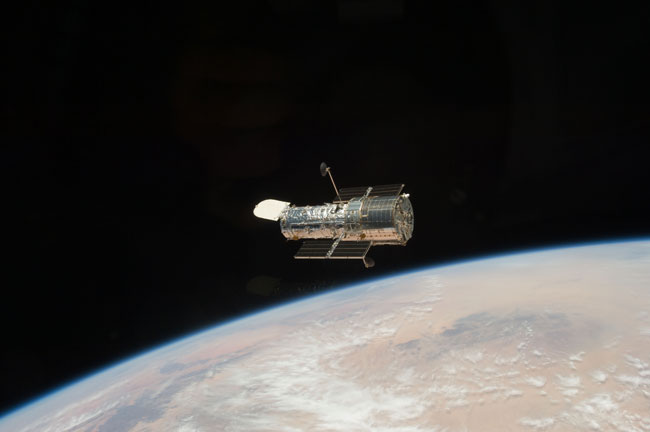Donated Space Telescopes Are Failed US Spy Satellite Program's Leftovers

Two large optical telescope assemblies bequeathed to NASA by the U.S. National Reconnaissance Office (NRO) were built for a satellite imaging program that was canceled in 2005 due to lengthy delays and massive cost overruns, according to multiple sources.
The multibillion-dollar program, dubbed Future Imagery Architecture, or FIA, was an infamous flop that damaged the NRO’s longstanding reputation for technical wizardry.
NASA announced June 4 that it had taken ownership of the telescope hardware, currently in storage at the facilities of manufacturer ITT Exelis Geospatial Systems of Rochester, N.Y.
NASA has yet to identify a science mission that would use the telescopes, which feature mirror apertures with a diameter of 8 feet (2.4 meters) — the same as that on the space agency’s uberproductive Hubble Space Telescope astronomy flagship.
Loretta DeSio, a spokeswoman for the secretive NRO, declined to identify the program for which the telescope assemblies were built. She characterized the hardware as "residual spacecraft hardware from a past program." [Photos: Declassified U.S. Spy Satellites]
But DeSio did say the hardware was built in the late 1990s and early 2000s. That time frame matches the development schedule for FIA, which was supposed to be the NRO’s next generation of optical and radar imaging satellites.
Leftover telescopes
Breaking space news, the latest updates on rocket launches, skywatching events and more!
Multiple sources confirmed the donated telescopes were indeed left over from FIA, with one saying the hardware’s likely cost was several hundred million dollars. On NRO programs of FIA’s scale, tens of millions of dollars are spent on design work before any hardware is built, this source noted.
In a move that stunned the space industrial community, the NRO in September 1999 awarded Boeing Space and Intelligence Systems, of El Segundo, Calif., the contract to build both the optical and radar components of FIA. In winning the contract, Boeing unseated incumbent Lockheed Martin Space Systems of Denver, which for decades had reigned as the builder of NRO’s classified optical and radar imaging craft.
But Boeing quickly ran into troubles on the highly ambitious and complex FIA program, which fell years behind schedule and overran its budget by billions of dollars. In 2005, having concluded that Boeing’s problems were intractable, the Office of the Director of National Intelligence directed the NRO to terminate the optical portion of the contract. The NRO simultaneously contracted with Lockheed Martin to cobble together a gapfiller imaging capability using leftover hardware from a legacy system.
Boeing retained the contract for the radar satellites.
The cancellation of the optical portion came before construction began on the satellite platforms, sources said. The NRO’s total investment in FIA is classified, but given the size of the program it likely was in the billions of dollars.
The roots of a failed program
Some intelligence officials have attributed the fiasco to a misguided attempt to foment industrial competition in an area that had for all intents and purposes been a Lockheed Martin monopoly. The NRO has since disclosed plans to award Lockheed Martin a sole-source contract to build a highly capable imaging system known as Next-Generation Optical.
Among Boeing’s subcontractors on the canceled program was a division of Eastman Kodak of Rochester, which for years had built the mirror assemblies for the nation’s spy satellites. That division was sold to ITT Exelis in 2004.
In an email, ITT Exelis spokeswoman Irene Lockwood confirmed that her company built the hardware. “Since developing and building the two partial telescope assemblies in the late 1990s-early 2000s, ITT Exelis has stored the hardware in one of our Rochester facilities. As the future space missions for the telescopes evolve, ITT Exelis will work with NASA to determine how best they can be used.”
DeSio declined to say how much the NRO had been paying ITT Exelis to store the hardware, or whether those costs have been transferred to NASA. Industry sources said this type of hardware is typically stored in environmentally controlled, secure facilities at a cost that could equal or exceed $1 million per year. ITT Exelis lost out to Goodrich Corp. of Charlotte, N.C., in a competition to build the telescope mirrors for the Next-Generation Optical system.
This article was provided by Space News, dedicated to covering all aspects of the space industry.
Warren was the former Editor-in-Chief for SpaceNews from 2008-2016 where he set editorial direction for weekly newspaper and website covering global space industry. He also led editorial team including reporters in Washington, Paris, San Francisco, Bangalore, Moscow and Tokyo; and freelance photographers and graphic designers. He's currently a senior strategist for BryceTech out of Alexandria, VA.

